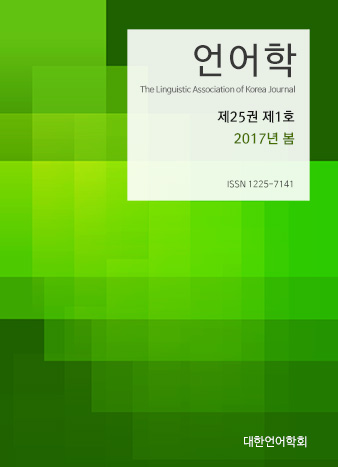대한언어학회 전자저널

-
Why is the Locative NP in Kiswahili not Syntactically Oblique?
-
Developmental Errors in Chinese L1 Speakers’ Use of the L2 English Past Tense and Perfective Aspect
-
An Exploration of High School Reading Test Items Based on Discriminant Analysis
-
Marketization of University Brochures in Korea and the US: From a Genre Analysis Perspective
25권 1호 (2017년 3월)
- Developmental Errors in Chinese L1 Speakers’ Use of the L2 English Past Tense and Perfective Aspect
-
Aijing Li & Mun-Hong Choe
Pages : 29-53
Abstract
Keywords
# Chinese # EFL # simple past # present perfect # past perfect
References
- Coppetiers, R. (1987). Competence differences between native and non-native speakers. Language, 63, 544-573.
- Hackmack, S. (2007). Reichenbach’s theory of tense and its application to English. Retrieved from http://www.fb10.uni-bremen.de/khwagner/verb/ pdf/Reich.pdf.
- Bardovi-Harlig, K. (1992). The relationship of form and meaning: A cross-sectional study of tense and aspect in the interlanguage of learners of English as a second language. Applied Psycholinguistics, 13, 253-277.
- Bardovi-Harlig, K. (1998). Narrative structure and lexical aspect: Conspiring factors in second language acquisition of tense-aspect morphology. Studies in Second Language Acquisition, 20(4), 471-508.
- Hinkel, E. (1992). L2 tense and time reference. TESOL Quarterly, 26, 557-572.
- Iatridou, S., Aangnostopoulou, E., & Lzorski, R. (2001). Observations about the form and meaning of the perfect. Current Studies in Linguistics Series, 36, 189-238.
- Katz, G. (2003). A modal account of the English present perfect puzzle. In Proceedings of SALT (Vol. 13, pp. 145-161).
- Klein, W. (1992). The present perfect puzzle. Language, 68, 525-552.
- Klein, W. (1994). Time in language. London: Routledge.
- Klein, W. (2000). An analysis of the German perfect. Language, 76, 358-382.
- Larsen-Freeman, D. (2006). The emergence of complexity, fluency, and accuracy in the oral and written production of five Chinese learners of English. Applied Linguistics, 27(4), 590-619.
- Matthews, S., & Yip, V. (1994). Cantonese: A comprehensive grammar. London: Routledge.
- McCoard, R. W. (1978). The English perfect: Tense choice and pragmatic inferences. Amsterdam: North-Holland Press.
- Pancheva, R., & von Stechow, A. (2004). On the present perfect puzzle. In Proceedings of NELS (Vol. 34, No. 2, pp. 469-484).
- Park, M., & Choe, M. H. (2013). Korean EFL learners’ use of the English simple past and present perfect. The Linguistic Association of Korea Journal, 21, 119-146.
- Portner, P. (2003). The temporal semantics and modal pragmatics of the perfect. Linguistics and Philosophy, 26(4), 459-510.
- Reichenbach, H. (1947). Elements of symbolic logic. London: Macmillan.
- Robinson, P. (1995). The aspect hypothesis revisited: A cross-sectional study of tense and aspect marking in interlanguage. Applied Linguistics, 16, 344-370.
- Saeed, J. I. (2009). Semantics. West Sussex: Wiley-Blackwell Press.
- Salaberry, M. R., & Shirai, Y. (Eds.). (2002). The L2 Acquisition of Tense Aspect Morphology. Amsterdam/Philadelphia: John Benjamins Publishing.
- Smith, C. S. (1983). A theory of aspectual choice. Language, 59, 479-501.
- Yang, S., & Huang, Y. Y. (2004). The impact of the absence of grammatical tense in L1 on the acquisition of the tense-aspect system in L2. IRAL, 42(1), 49-70.
- Yoon, Y. (2012). The English present perfect and simple past tense. Linguistic Research, 29(3), 485-513.
- Yuan, H. (2005). The acquisition of tense-aspect morphology: A cross-sectional study of the native ESOL learners’ interlanguage. Doctoral dissertation, University of Georgia.